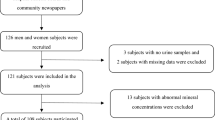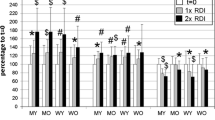Abstract
The aim of this study was to confirm if there is a link between the alteration in blood levels of trace elements (chromium, copper, lead, cadmium, and zinc) and dehydroepiandrosterone sulfate (DHEAS) in healthy and diabetic states. This study is the first study to test these parameters in Egyptians. The study included 150 subjects divided into the following four groups: healthy middle-aged, healthy elderly, middle-aged diabetics, and elderly diabetics. Our results revealed a statistically significant decrease in the level of DHEAS in the elderly compared to middle-aged healthy and diabetic groups (p < 0.05). There was a significant difference between the middle-aged groups with respect to zinc, copper, chromium, and cadmium levels. Zinc and copper were lower in the diabetic subjects while chromium and cadmium were higher in the same group in comparison to healthy subjects. In the elderly groups, there were significant increases in chromium and cadmium levels in diabetic subjects rather than healthy ones. There was a significant increase in the thiobarbituric acid reactive substance level in the elderly healthy and diabetic groups and a significant decrease in the glutathione level in the elderly groups. There was no correlation between the levels of trace elements and DHEAS or between the levels of DHEAS, oxidants, and antioxidants in all of the tested groups. In conclusion, only the DHEAS level was correlated with age. There was no difference between the diabetic and healthy groups with respect to the levels of trace elements, with the exception of chromium and cadmium, which suggests the effect of pollution on the pathogenesis of diabetes in Egyptians. No correlation existed between the levels of DHEAS and trace elements, oxidants, and antioxidants. Finally, we believe that there is a large regional variation in the levels of trace elements due to different environmental exposure and nutritional factors which are responsible for contradictory results regarding the pathogenesis of diseases related to alterations in the levels of trace elements.






Similar content being viewed by others
References
Saleh F, Behbehani A, Asfar S, Khan I, Ibrahim G (2010) Abnormal blood levels of trace elements and metals, DNA damage, and breast cancer in the State of Kuwait. Biol Trace Elem Res (in press)
Kazi TG, Afridi HI, Kazi N, Jamali MK, Arain MB, Jalbani N, Kandhro GA (2008) Copper, chromium, manganese, iron, nickel, and zinc levels in biological samples of diabetes mellitus patients. Biol Trace Elem Res 122:1–18
Merali Z, Singhal RL (1975) Protective effect of selenium on certain hepatotoxic and pancreotoxic manifestations of subacute cadmium administration. J Pharmacol Exp Ther 195(1):58–66
Schrauzer GN (2008) Effects of selenium and low levels of lead on mammary tumor development and growth in MMTV-infected female mice. Biol Trace Elem Res 125:268–275
Blowes D (2002) Tracking hexavalent Cr in groundwater. Science 295(5562):2024–2025
Leowattana W (2004) DHEAS as a new diagnostic tool. Clin Chim Acta 34:1–15
Klevay LM, Christopherson DM (2000) Copper deficiency halves serum dehydroepiandrosterone in rats. J Trace Elem Med Biol 14:143–145
Alrefai H, Allababidi H, Levy S, Levy J (2002) The endocrine system in diabetes mellitus. Endocr 18(2):105–119
Kawano H, Yasue H, Kitagawa A, Hirai N, Yoshida T, Soejima H, Miyamoto S, Nakano M, Ogawa H (2003) Dehydroepiandrosterone supplementation improves endothelial function and insulin sensitivity in men. J Clin Endocrinol Metab 88:3190–3195
Kruse-Jarres JD, Rukgauer M (2001) Trace elements in diabetes mellitus. Peculiarities and clinical validity of determinations in blood cells. J Trace Elem Med Biol 14:21–27
Metello Jacob MHV, Janner DR, Kucharski MPJL, Klein AB, Ribeir MFM (2010) Age-related effects of DHEA on peripheral markers of oxidative stress. Cell Biochem function Cell Biochem Funct 28:52–57
Abou-Seif MA, Youssef A-A (2004) Evaluation of some biochemical changes in diabetic patients. Clin Chim Acta 2:161–170
Yoshida K, Hirokawa J, Tagami S, Kawakami Y, Urate Y, Kondo T (1995) Weakened cellular scavenging activity against oxidative stress in diabetes mellitus: regulation of glutathione synthesis and efflux. Diabeteologia 38(2):201–210
Balasubramaniyan N, Subramanian S, Sekar N, Bhuvarahamurthy V, Govindasamy S (1994) Involvement of plasma copper, zinc and cadmium in human carcinoma of uterine cervix. Med Sci Res 22:475–476
Zheng Y, Li X, Wang Y, Cai L (2008) The role of zinc, copper and iron in the pathogenesis of diabetes and diabetic complications: therapeutic effects by chelators. Hemoglobin 32:135–145
Kazi TG, Afridi HI, Kaazi N, Jamali MK, Arain MB, Jalbani N, Kandhro GA (2008) Copper, chromium, manganese, iron, nickel, and zinc levels in biological samples of diabetes mellitus patients. Biol Trace Elem Res 122:1–18
Goldblum SE, Cohen DA, Jay M, McCain CJ (1978) Zinc metabolism in the elderly. In: McClain CJ, Stuart MA (eds) Raven Press, New York, p 167
Ruνz C, Alegrνa A, Barberα R, Farrι R, Lagarda J (1998) Selenium, zinc and copper in plasma of patients with type 1 diabetes mellitus in different metabolic control states. J Trace Elem Med Biol 12:91–95
Kruse-Jarres JD, Rukgauer M (2000) Trace elements in diabetes mellitus. Peculiarities and clinical validity of determination in blood cells. J Trace Elem Med Biol 14:21–27
Chen MD, Lin WH, Lin PY, Wang JJ, Tsou CT (1991) Investigation on the relationships among blood zinc, copper, insulin and thyroid hormones in non-insulin dependent diabetes mellitus and obesity. Zhonghua Yi Xue Za Zhi (Taipei) 48(6):431–438
Ekmekciog LUC, Christian P, Katerina P, Iles S, Guntram S, Wolfgang M (2001) Concentrations of seven trace elements in different hematological matrices in patients with type 2 diabetes as compared to healthy controls. Biol Trace Elem Res 79:204–218
Mooradian AD, Morley JE (1978) Copper. In: Morley JE, Glick Z, Rubenstein L (eds) Geriatric nutrition a comprehensive review. Raven, New York, p 175
Longnecker MP, Daniels JL (2001) Environmental contaminants as etiologic factors for diabetes. Environ Health Perspect 109(6):871–876
Schwartz GG, Il’yasova D, Ivanova A (2003) Urinary cadmium, impaired fasting glucose, and diabetes in the NHANES III. Diab Care 26(2):468–470
Haswell-Elkins M, Satarug S, O’Rourke P, Moore M, Ng J, McGrath V, Walmby M (2008) Striking association between urinary cadmium level and albuminuria among Torres Strait Islander people with diabetes. Environ Res 106(3):379–383
Wiernsperger NF (2003) Oxidative stress as a therapeutic target in diabetes: revisiting the controversy. Diabetes Metab 29:579–585
Kameda W, Daimon M, Oizumi T, Jimbu Y, Kimura M, Hirata A, Yamaguchi H, Ohnuma H, Igarashi M, Tominaga M, Kato T (2005) Association of decrease in serum dehydroepiandrosterone sulfate levels with the progression to type 2 diabetes in men of a Japanese population: the Funagata Study. Metabolism 54(5):669–676
Martínez JJM, Queipo ZA, Ferrandis CC, Queipo ZJA, Gil SM, Chuan NP (2008) Changes in sexual hormones in a male population over 50 years of age. Frequency of low testosterone levels and risk factors. Actas Urol Esp 32(6):603–610
Petrussi E, Pinzani P, Orlando C, Poggesi M, Monami M, Pazzagli MG (2002) Age related changes in serum total antioxidant capacity, DHEAS and insulin like growth factor-1. Evidence in healthy centenarians subjects. Arch Gerontol Geriatr 8:265–271
Acknowledgement
Special thanks to the staff in the Endocrinology and Diabetes Clinic of Kaser El Eini for the facilities during sampling and revising the filing system of the patients.
Conflict of Interest
No conflicts of interest.
Author information
Authors and Affiliations
Corresponding author
Rights and permissions
About this article
Cite this article
El Husseiny, N.M., Said, E.S., El Shahat Mohamed, N. et al. Impact of Trace Element Changes on Dehydroepiandrosterone Sulfate in Healthy and Diabetic States among Middle-Age and Elderly Egyptians. Biol Trace Elem Res 143, 1451–1460 (2011). https://doi.org/10.1007/s12011-011-9012-2
Received:
Accepted:
Published:
Issue Date:
DOI: https://doi.org/10.1007/s12011-011-9012-2




